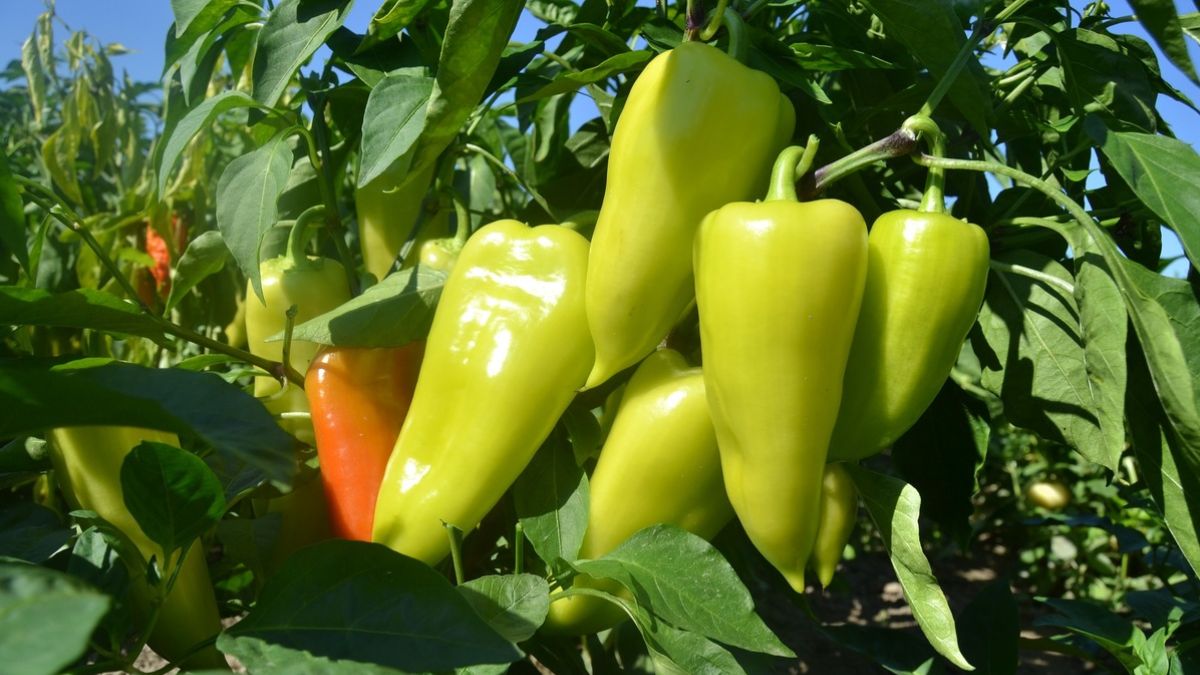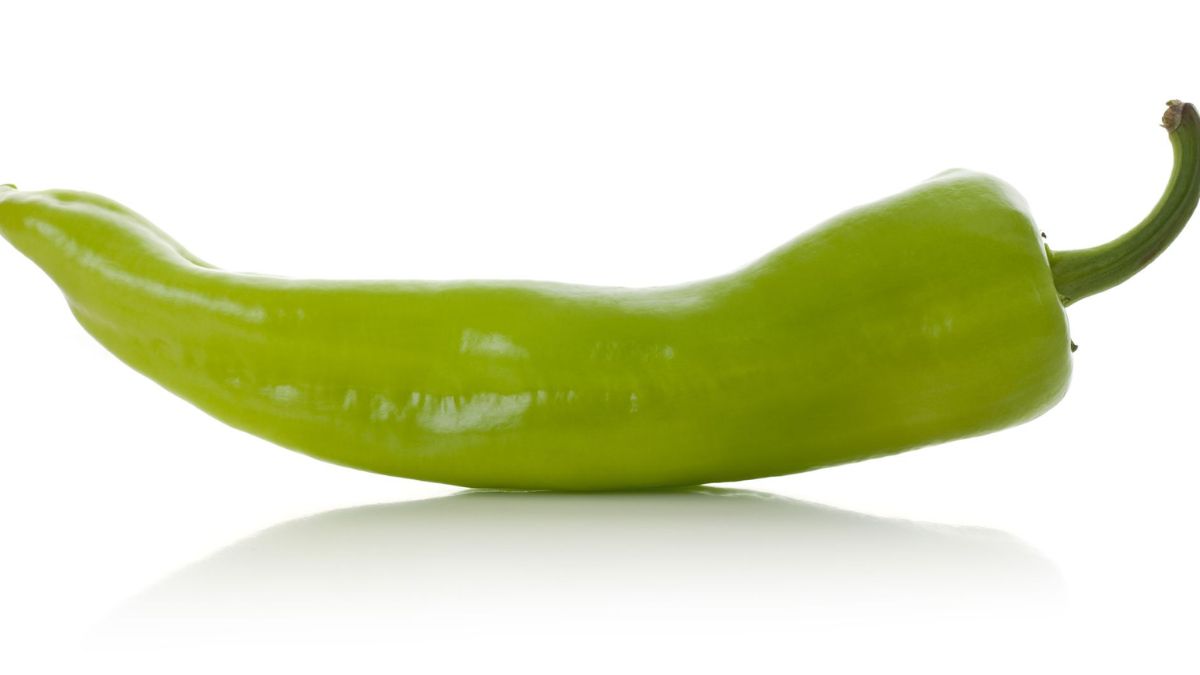The Cubanelle pepper, sometimes known as Cuban pepper, is sweet, mild capsicum mainly found in Puerto Rican, Cuban, and Dominican cuisines. It’s fantastic for preparing sauces, adding to pizza, stuffing, and eating raw. These six-inch peppers, commonly found in supermarkets, are worth knowing because they’re a delicious, vivid, and economical way to add flavor to various foods. Though it’s officially recognized as a Cubanelle, this sweet type has gained the moniker “Italian frying pepper” since it’s typically cooked with oil in a frying pan and consumed that way, according to Chili Pepper Madness. The pepper originated in Italy, although it has become more prevalent in Latin American cuisine than in Italian cuisine over time.
According to Pepper Scale, most Cubanelles are now imported from the Dominican Republic. These peppers are long and slender, with a length of up to 6 inches and a width of up to 2 inches. While they can be spicy, most Italian frying peppers have a Scoville rating of less than 1,000. (a serrano, for comparison, averages around 10,000 units, per The Seattle Times). While Cubanelles are harvested, they should not be ripe; according to Chili Pepper Madness, these peppers usually are picked unripe when they are still yellow-green. They can be utilized when completely ripe. However, they will be a rich orange or red color.
What are Cubanelle Peppers?
Cubanelle peppers range from six to eight inches, with a slight curl at the tail end. Peppers are typically marketed when they are bright green, but they can also be found in shades of yellow, orange, and red as they grow. Depending on the growing region, they bloom from late July to September. The majority of them come from the Dominican Republic and are imported to the United States.
The hardy Cubanelle pepper, which has its origins in South and Central America, is a classic ingredient in sofrito, a tomato, pepper, and garlic base used in various cuisines. Cubanelles are also popular in Italian cuisine, thanks to Spanish and Portuguese explorers who introduced them to the continent.
Cubanelle peppers are filled and baked in Sicily with pine nuts, bread, and seasonings. The typical Italian sausage sandwich, topped with sauteed Cubanelle peppers, is another popular dish.
What are the Uses for Cubanelle Peppers?
These peppers have a mild sweet spice, making them an excellent addition to rich meals like cheese, meats, and sauces. Because the pepper isn’t too thick and has low water content, it can be flash-fried to give flavor and depth to an omelet or dress up a salad. Instead of green bell peppers, thinly slice them to add flavor to homemade pizza.
Salads, casseroles, and a yellow mole sauce are common uses for Cubanelles. They’re also fantastic on subs or pizza, and they can be stuffed with whatever filling you choose.
You can use them in everyday cooking, just like any other bell pepper, for example, in a mirepoix. Cubanelle peppers are ideal for producing stuffed peppers due to their large pods. You can stuff them with whatever you want, then bake or grill them to your heart’s content.
Cubanelle peppers are used in cooking throughout Central America, especially Cuba, Puerto Rico, and the Dominican Republic. However, they are increasingly available in US stores and have been used in cooking for a long time.
What do Cubanelle Peppers Taste Like?
Cubanelle peppers have a mild honey-pepper flavor and a low heat level. They aren’t as spicy as typical sweet peppers, but they aren’t as mild either. The Cubanelle’s flesh is thinner than that of bell pepper or a poblano, and it resembles that of an Anaheim pepper. Due to its decreased water content, raw Cubanelle pepper has a nice snap and soft texture. The Cubanelle, sometimes known as “Cuban pepper” or “Italian frying pepper,” is a sweet pepper type belonging to the Capsicum annuum species. It is a light yellowish-green tint while unripe, but it turns a vibrant red color when allowed to ripen.
Are Cubanelle Peppers Healthy, and Where can you buy them?
Because Cubanelle peppers are fruits, they’re naturally high in vitamins and minerals. They offer a comparable nutritional profile to other sweet peppers like bell peppers, claims Bonnie Life. According to the website, Cubanelle peppers are a good source of vitamin C, vitamin A, and B6. According to Nutritionix, Cubanelle peppers have no fat and only 20 calories per pepper. These peppers are also ideal as a light and nutritious snack, as they contain only 4 grams of carbs.
Those who want to try these sweet peppers are in luck; they’re becoming increasingly popular at supermarkets across the country. According to Walmart’s website, they’re accessible in retailers like Walmart and supermarket delivery services like Instacart. Growing them is similar to growing bell peppers for people who desire to cultivate them. According to Gardening Know How, cubanelle seeds should be grown inside four weeks before the first frost, then transplanted outside after the frosts have passed. They’ll be ready to pick in around 75 days if you give them full sun and a reasonable amount of water.
Visit a specialist fruit and vegetable store or farmers’ market in late summer or early fall to get this wonderful capsicum. Look for a long, brilliant green, yellow, orangish-red pepper with a tiny curl to the skin and a few wrinkles on the outside. They do well in summer gardens as well.
How to Cook with Cubanelle Peppers?
Cubanelles are classified as sweet peppers, yet they can have a moderate heat. In Cuba, Puerto Rico, and the Dominican Republic, their taste pallet helps Latin American food, according to Pepper Scale. The pepper is also utilized in several sofrito dishes made out of onions, garlic, and peppers and varies depending on where they’re made.
Cubanelles can be eaten whole when fried in oil, but they also work well sliced and added to sandwiches or pizza topping (fried or raw). They’re frequently packed with items like chorizo and cheese and baked in the same way as stuffed bell peppers. Cubanelles have thinner skin than poblanos or bell peppers, which according to Chili Pepper Madness, makes them ideal for stuffing and baking because they take less time to cook. In addition, their sweet heat provides a superb flavor balance with the filling.
Conclusion
Fresh and intact, these peppers can survive for weeks in the crisper drawer of your refrigerator. To reduce moisture loss, store any cut, unused pepper in a container. Use leftover cooked peppers within a few days by storing them in an airtight container. The crisp snap of fresh pepper is delightful, and that is unless you’re biting into a ghost or habanero pepper. Approximately 50,000 pepper varietals are grown worldwide, according to Thrillist. It appears impossible to distinguish them all as a result. Peppers are one of the most unusual foods because the flavor and spiciness of each one vary greatly. Peppers can be sweet and tart to scorching hot, like the Caroline reach, according to PepperHead.
Jalapenos and bell peppers are well-known, but others are used for specialised cuisines. Latin American and Italian cuisines use the sweet-to-spicy Cubanelle pepper (Capsicum annum Cubanelle). Cubanelle peppers are milder than jalapeños, with a Scoville Heat Unit rating of 0 to 1,000. Because jalapeno peppers have an average temperature of 5,000 SHU, the hottest Cubanelle pepper is still five times gentler than a typical jalapeno pepper. Depending on your heat preference and tolerance, you may still feel a tinge of heat.

